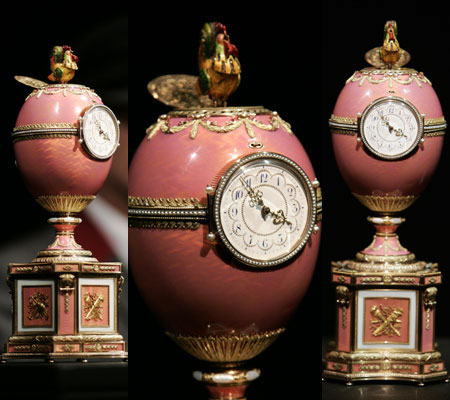
The Cristies lot notes describes the egg as:
A JEWELLED VARI-COLOURED GOLD-MOUNTED AND ENAMELLED EGG ON PLINTH, INCORPORATING A CLOCK AND AN AUTOMATON
Lot NotesHere's the Christies press release announcing the auction:
This previously unrecorded Fabergé egg is known from the codicil to her will quoted above to have been given to Germaine Alice Halphen on her engagement to Baron Edouard de Rothschild in Paris, and married in 1905. It was a gift from Edouard's elder sister Béatrice (also known as Béatrix) Ephrussi, née de Rothschild, and has remained in the recipient's family until now.
Fifty Imperial eggs were produced and delivered by the Fabergé workshops in St. Petersburg as recorded by Tatiana Fabergé, Lynette Proler and Valentin Skurlov in their book The Fabergé Imperial Easter Eggs, London, 1997, although not all survive.
Between 1885 and 1896, eleven were commissioned by Emperor Alexander III (1881-96) as Easter gifts to his wife, Maria Feodorovna, née Princess Dagmar of Denmark. The remainder were given by Nicholas II to his mother as well as to his wife, Alexandra Feodorovna, née Princess Alix of Hesse und bei Rhein, from 1896 to 1916. These eggs, representing the Resurrection, were given on the moveable Feast of Easter ('Paskha' in Russian) each year except 1904 and 1905, on account of the Russo-Japanese war.
Comparable in importance and quality and, indeed rarer than, the Imperial eggs, a very few eggs were produced by the Fabergé workshops in St. Petersburg for a select group of exceptionally wealthy private clients. These include the Egg acquired by the Duchess of Marlborough, née Consuelo Vanderbilt, during her visit to St. Petersburg in 1902, the Iusupov Egg of 1907 commissioned by Prince Felix Iusupov, as a 25th wedding anniverary present for his wife, Zinaida, and Dr. Emmanuel Nobel's Ice Egg. (Tatiana Fabergé, et al, op. cit., pp. 70-91.)
Another enormously wealthy client, Alexander Kelkh, presented his wife, Varvara Petrovna, née Bazanova, no fewer than seven large Fabergé eggs between 1898 and 1904, the last being the Chanticleer Egg. Practically identical to the present egg, it is enamelled in blue, with variations to the plinth, and to the rose-diamonds on the cockerel's throat. This repetition of form in different colours is not unique and is mirrored in the Imperial Blue Serpent Clock Egg of 1887 and the translucent pink Duchess of Marlborough Clock Egg of 1902.
Both the Rothschild egg and the Chanticleer egg are in fact similar in style to the Imperial Cockerel (formerly Cuckoo) Egg of 1900. All these were inspired by the famous ormolu automaton Peacock Egg in the Winter Palace made by James Cox (d.1788). For over 20 years Carl Fabergé voluntarily gave his time and expertise, to the Imperial Hermitage, repairing, restoring and classifying its treasures. Fabergé, together with a mechanic, were known to have examined and repaired the automaton Peacock Clock, and familiarity with this large-scale mechanical work of art led to the design, of the smaller 1900 Cockerel Easter Egg, and the slightly later Rothschild and Chanticleer Eggs.
In fact these three large eggs are the only Fabergé eggs incorporating both a clock and an automaton. While it has not been possible to examine the movement of the Cockerel Easter Egg, from the description of that of the Chanticleer Egg, the latter's appears to be identical to that of the Rothschild Egg. (A. Chapuis and E. Droz, Automata, Switzerland, 1958, pp. 229-232, figs. 280-284.)...MORE
THE ROTHSCHILD FABERGÉ EGG TO BE OFFERED AT CHRISTIE’S LONDON IN NOVEMBER 2007